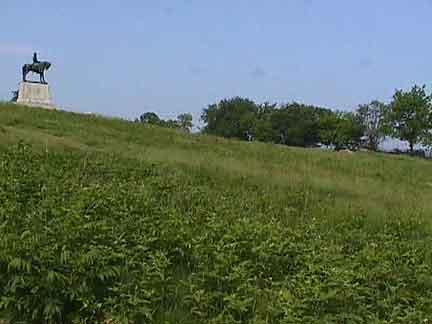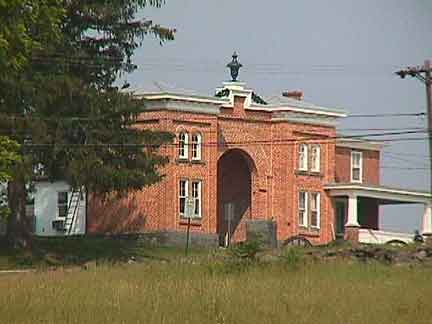 |
|
|
 |
|
|
The Civil War veterans were very much involved in the monument placement. While those interested in the battle might wish battle field conservation, one can't truly begrudge the placement of a cemetery on hallowed ground. It is similarly awkward for a tourist to complain of tourists traps. Still, Cemetery Hill is not my favorite area of the battle field. Most of the Cemetery Hill photos are in the 'monuments' section of these pages. The following pictures emphasize East Cemetery Hill, where modern civilization has infringed less.
 |
|
There is a row of cannon between the statue and the hill crest. The statue is General Howard of the XI Corps, who briefly commanded the field after Reynolds's death. |
This is the steepest part of the hill, too steep in fact. Guns placed firing north to the town or west towards Seminary Ridge had fairly gentle slopes, and could fire at any approaching force. To the east, while the height gives advantage in firing at a distance, troops close in at the base of the hill could not be hit. If one fired a civil war era cannon with the muzzle parallel to the ground or upwards, the carriage allowed recoil, the gun would roll backwards a dozen feet. One task of the gun crew was to roll it back in position. If the nuzzle was pointed downwards, below the horizon, the recoil would lift the gun into the air, and send it tumbling. While the defending infantry appreciated this slope, and the park service has lined up an impressive array of cannon along the crest of the hill to defend it, operating the guns at targets close to the base of the hill was problematic.
 |
|
|
Cemetery and Culp's Hill are connected by a low ridge. The stonewall shown was defended by the XI Corps from an attack by Early's division of Ewell's Corps.
 |
|
|
The gatehouse picture was taken from very near where the prior "Lovely Ground" picture was taken, the 'saddle' between Cemetery and Culp's Hills. The infantry monuments are a the bottom of the hills, while the guns marking artillery positions are a the top. This arrangement isn't ideal from the infantry's perspective. One infantry commander on Cemetery Hill - after a demonstration that friendly fire isn't - threatened to fix bayonets and charge his own artillery battery.
 |
|
Four pictures were spliced together to get this view. |
In the years immediately following the battle, Culp's Hill was a favorite gathering place for tourists. The hill had been wooded at the time of the battle, as it is wooded now. However, the intense cannon fire by both sides had knocked down most of the trees. For a decade or so, Culp's Hill was the best true monument to the violence of period weapons.
Unfortunately, with the trees grown back, it is hard to convey the terrain and flow of the battle with a digital camera.
The Culp's Hill fight was commanded on the Union side by a West Point regular who spent considerable time with the Engineers. While most commanders to this point in the war did not have their troops dig, considerable Union breastworks were dug on Culp's Hill, and were a major factor in the defense. This policy of digging in soon spread to both armies, ultimately leading to the siege of Petersburg.
Next : Closing Comments Overview of the July 2 and July 3 fighting, and commentary.